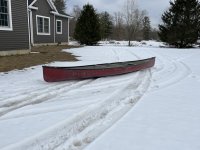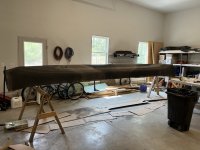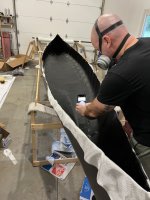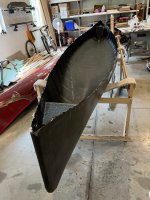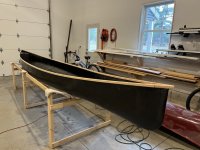-
Happy National Zipper Day (pat. 1913)! 🤐
You are using an out of date browser. It may not display this or other websites correctly.
You should upgrade or use an alternative browser.
You should upgrade or use an alternative browser.
Sawyer 17’9” Cruiser on a diet
- Thread starter stripperguy
- Start date
This is my son, SIL, and nephews fault. They all wanted the paddling experience of that hull without the suffering side of carrying it.
Son Josh bought enough carbon and glass to make 4 copies, as well as replenishing my supply of polyester resin.
Why polyester? It’s cheap, half the cost of epoxy.
The Sawyer had some wear and tear from years of misuse, I patched that up along with removing 30 years (a guess) of grime. Removed all trim and applied 3 full coats of PVA mold release.
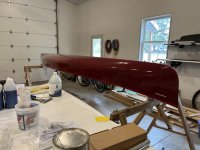
Son Josh bought enough carbon and glass to make 4 copies, as well as replenishing my supply of polyester resin.
Why polyester? It’s cheap, half the cost of epoxy.
The Sawyer had some wear and tear from years of misuse, I patched that up along with removing 30 years (a guess) of grime. Removed all trim and applied 3 full coats of PVA mold release.

And that’s as far as we got with it.
I have a shoulder replacement coming up soonly, and likely won’t finish the build til spring.
All that’s left to finish is a few thwarts and two seats.
Sawyer weight 75 lbs
SC-1 (Sawyer copy 1) weight 36 lbs
Final weight likely 42 lbs.
Son Josh wants SC-2 to be full foam substrate, no carbon, all glass. We’ve been toying with heat forming the Divinycell, but have yet to arrive at an optimal method. Oh, and costs are about $500 per boat.
Final note: hull is much stiffer than the original Sawyer behemoth.
I have a shoulder replacement coming up soonly, and likely won’t finish the build til spring.
All that’s left to finish is a few thwarts and two seats.
Sawyer weight 75 lbs
SC-1 (Sawyer copy 1) weight 36 lbs
Final weight likely 42 lbs.
Son Josh wants SC-2 to be full foam substrate, no carbon, all glass. We’ve been toying with heat forming the Divinycell, but have yet to arrive at an optimal method. Oh, and costs are about $500 per boat.
Final note: hull is much stiffer than the original Sawyer behemoth.
Fantastic project.
Did you wet out the carbon and two layers of Eglass at the same time?
How much resin in total would you say was used?
Would you do anything differently next time?
Bob
Did you wet out the carbon and two layers of Eglass at the same time?
How much resin in total would you say was used?
Would you do anything differently next time?
Bob
Great work on the copies. Thinking about doing one myself.
More questions.......
How was it to work with poly resin - viscosity, working time etc.?
Did you do any heat bending of the divinycell ribs or core? How did you form them?
Would you save any weight with 2 layers carbon and only 1 of the glass?
Mark
More questions.......
How was it to work with poly resin - viscosity, working time etc.?
Did you do any heat bending of the divinycell ribs or core? How did you form them?
Would you save any weight with 2 layers carbon and only 1 of the glass?
Mark
Fantastic project.
Did you wet out the carbon and two layers of Eglass at the same time?
How much resin in total would you say was used?
Would you do anything differently next time?
Bob
Bob,
Yes, we wet out all 3 layers of cloth at once. It was tricky to see when the innermost layer, the carbon, was fully wetted out. After we popped the shell, I saw a few small areas that were not fully saturated in the carbon. There was little cause for concern, as more resin and cloth would be added anyway.
We did the wet out, and two heavy covering coats using, uhmmm, maybe 2 gallons total? And another 16 oz plus Cabosil to stick down the bottom stiffener and ribs, and another 32 oz for wet out of the innermost added glass layer.
Would we do anything different next time? Oh God yes.
Biggest change would be a switch to epoxy resin, all of us are just more comfortable with it. No fiddling with catalyst ratios, no laminating vs finishing resin (with wax), no fumes that stink up my shop for weeks...
We should have been more careful with the ribs. While they serve an important function, we didn't think far enough ahead. We ran each and every rib up to the rough sheer line. No problem to trim the ribs and sheer line to shape, but now we had varying hull thickness at the sheer. Thin hull between ribs, thick hull at each rib.
Grrr!
We ultimately just cut a fat rabbet in the cap gunnel, and filled the gap as needed with resin. It worked out OK, but we should have planned to keep the ribs below the gunnels, rather than IN them.
My son still wants to do the next one with a full Divinycell substrate, and no carbon at all.
We haven't yet come up with an easy method to build that way over a male plug.
Great work on the copies. Thinking about doing one myself.
More questions.......
How was it to work with poly resin - viscosity, working time etc.?
Did you do any heat bending of the divinycell ribs or core? How did you form them?
Would you save any weight with 2 layers carbon and only 1 of the glass?
Mark
Mark,
The polyester resin is easy enough to work with, with some caveats.
Even with excellent chem vapor masks, it still stinks badly. For weeks! Good thing my shop is a driveway away from the house.
Working time was adequate, but we had to always be mindful of working a sharp wet line. If we had a sloppy line, there could be a situation where the resin would kick at the surface, but without fully saturating the layers below. So whenever we ran low on resin, we had to be sure to keep a crisp line, should the next mix take longer than anticipated.
The viscosity was quite low, so penetrating all 3 layers was easy enough, probably took about half the time as epoxy resin would have.
We initially chose the polyester due to low cost, but my son bought a total of 9 gallons of RAKA epoxy resin for not much more per gallon than the polyester. Quantity purchases are key.
Heat forming the H80 foam for the ribs was easier than I expected. We used a Harbor Freight heat gun, set on about 500 F. The ribs were especially fun to form, just hold in place, waft over with the heat gun for 10 seconds, and the rib just shlumps into shape/space. Hold it for maybe 30 seconds, and done. The bottom stiffener took more time, but it was equally easy to do. We have been messing around with more complex, compound curves, and that looks promising as well.
More carbon and less glass for weight savings? Dunno. While the carbon itself is low density, it is also fairly thick, so resin weight goes up too. Glass, more dense, is thinner, so less resin, but the glass itself is heavier. I'd have to run some numbers, but my gut tells me it's a wash. So it then becomes a fiscal issue...With carbon at roughly 4 times the cost of glass, you can see where I'd go next. The strength advantage of the carbon can easily be surpassed by adding section (the H80 foam) to a glass/foam/glass laminate. Besides, next build will have black pigmented resin, so we can tell everyone it's all carbon. As they say in the RV industry, as long as it looks good in the brochure...
Thanks SG, you answered my other question when you said you'd use epoxy on the next one. I think I'll stick with epoxy. Good to know about the DVcell formability. Sounds like the carbon has the same issue as kevlar as far as resin usage.
Mark
Mark
Thanks for sharing.
There's a guy in Florida who builds light hulls with foam construction panels, shapes them with a grinder, coats with fiberglass.
There's a guy in Florida who builds light hulls with foam construction panels, shapes them with a grinder, coats with fiberglass.
I missed this great thread yesterday !
Here are some of my thoughts, and questions.
Wetting three layers of Cloth will be a challenge, with epoxy, in my experience. Pot life and viscosity, the main demons. I'll stick to one layer at a time.
I know I had issues getting the carbon to wet out. I'll stick with S-glass, and Kevlar, and of course E-glass.
Vinyl Ester may be an alternative, as you can, at least adjust pot life, and should wet out easier, than epoxy ?
Question on fitting the foam to the bottom. Did you vacuum bag , to make the foam contact the hull ?
That was my biggest challenge.
I stripped an insert, to the shape of the mold, and it worked OK, but I still had some small voids.
Using very thin cedar strips, say less than 1/8", will give you plenty of stiffness, at least it has for me, and at a minimal cost, compared to foam.
The Advent of all these new composites, has really opened up the possibilities, for the home builder !
I really enjoyed your Build thread, Stripperguy ! Good luck with the surgery !
You are getting me pumped to build another composite.
Jim
Here are some of my thoughts, and questions.
Wetting three layers of Cloth will be a challenge, with epoxy, in my experience. Pot life and viscosity, the main demons. I'll stick to one layer at a time.
I know I had issues getting the carbon to wet out. I'll stick with S-glass, and Kevlar, and of course E-glass.
Vinyl Ester may be an alternative, as you can, at least adjust pot life, and should wet out easier, than epoxy ?
Question on fitting the foam to the bottom. Did you vacuum bag , to make the foam contact the hull ?
That was my biggest challenge.
I stripped an insert, to the shape of the mold, and it worked OK, but I still had some small voids.
Using very thin cedar strips, say less than 1/8", will give you plenty of stiffness, at least it has for me, and at a minimal cost, compared to foam.
The Advent of all these new composites, has really opened up the possibilities, for the home builder !
I really enjoyed your Build thread, Stripperguy ! Good luck with the surgery !
You are getting me pumped to build another composite.
Jim
Jim,
The polyester penetrated all the cloth easily, but definitely switching to epoxy next time.
The hull shape has such a shallow arch and mild rocker that heat forming the foam to shape was effortless.
We tossed a few 1 gallon ziplock bags filled with sand to hold the bottom stiffener in place, just in case. We ended up with one or two US quarter sized bubbles, no biggie.
My son and nephew both want to work on a female mold, but I don’t think it’s worth the effort for only a few more boats.
If we ever decide to go into production, then we’ll make a female mold for sure.
The polyester penetrated all the cloth easily, but definitely switching to epoxy next time.
The hull shape has such a shallow arch and mild rocker that heat forming the foam to shape was effortless.
We tossed a few 1 gallon ziplock bags filled with sand to hold the bottom stiffener in place, just in case. We ended up with one or two US quarter sized bubbles, no biggie.
My son and nephew both want to work on a female mold, but I don’t think it’s worth the effort for only a few more boats.
If we ever decide to go into production, then we’ll make a female mold for sure.
Jim,
I forgot to ask
Did you do any of your composite copies with the stems closed?
The Sawyer has no tumblehome and slightly laid out stems, I think I don’t need to leave the stems open. Pretty sure it would pop off the plug with fully finished stems.
I forgot to ask
Did you do any of your composite copies with the stems closed?
The Sawyer has no tumblehome and slightly laid out stems, I think I don’t need to leave the stems open. Pretty sure it would pop off the plug with fully finished stems.
Jim,
I forgot to ask
Did you do any of your composite copies with the stems closed?
The Sawyer has no tumblehome and slightly laid out stems, I think I don’t need to leave the stems open. Pretty sure it would pop off the plug with fully finished stems.
I was going to try that once with a tandem thinking the same thing. As I recall someone with experience sternly warned me against it. I believe the thinking was that the composite shrinks slightly when it cures and locks it solidly to the stems.
Alan
I left all mine open. You could get by just leaving one open.Jim,
I forgot to ask
Did you do any of your composite copies with the stems closed?
The Sawyer has no tumblehome and slightly laid out stems, I think I don’t need to leave the stems open. Pretty sure it would pop off the plug with fully finished stems.
There was a guy, over on the Bear Mountain Forum, ( Patricks Dad ), that built a Freedom 17. A tandem. He was able to lift his composite with both ends closed. The Freedom 17 has no tumblehome, and no recurve on the stems.
I'd be nervous closing both.
On the positive side, you would only need to cut the hull on one end, very carefully.
I think Alan should pull a copy of his Barracuda !
Thanks, Jim and Alan, I'll take it under advisement.
Gonna be off radar for a while, tomorrow is bionic shoulder day, no typing for a bit, but I should be able to browse...
Gonna be off radar for a while, tomorrow is bionic shoulder day, no typing for a bit, but I should be able to browse...
Good luck.
Jim
Jim
Similar threads
- Replies
- 10
- Views
- 650
- Replies
- 0
- Views
- 154

